Sometimes, there’s an oddball dish that catches my attention, and I find myself filled with the need to explore it further. The dish that has caught my attention, on and off since I moved here, is Pollo Maryland (Chicken Maryland) – the name changes at times – Suprema or Suprema de Pollo or Milanesa de Pollo (respectively a white meat cutlet, a white meat chicken cutlet, a dark meat chicken cutlet) leads the moniker; a few folk throw in “a la” before the Maryland. But you get the idea. I’m going to start with what I can find out about its origins, which isn’t a whole lot.
Not surprisingly, it seems to have started in the US state of Maryland. It’s one of those recipes that stretches back far enough that there’s no official recipe, it’s more or less “the way fried chicken was made in Maryland, different from southern fried chicken”. There seem to be two ways to go that make it different, much of which may just have depended on whether person making it had an oven or how much work it was to fire it up – it seems that the chicken pieces (often, but not always, first marinated in buttermilk) are simply dredged in flour and then shallow pan fried in either butter or lard until brown (never deep fried) – at that point, the pan is either put in the oven to finish cooking the chicken through, or, covered, leaving the chicken to steam in its own juices. The chicken is then served with a white pan gravy made from the drippings in the pan and the addition of either milk or cream. And that seems to be about as far as the “classic” goes.
As best I’ve been able to find, the first time the dish appeared in print as a standard recipe was in the 1896 edition of the Boston Cooking-School Cook Book, what later became the The Fannie Farmer Cookbook – Farmer’s version was an attempt to cut down further on fat, which she upfront admitted, so she used butter in place of lard, but just enough to baste the chicken (dredged in flour) while it baked in the oven, rather than fried atop the stove, and then created a cream sauce to go with it – how that reduced the fat from using lard, I’m not really clear.
Just a few years later, in 1908, apparently, Auguste Escoffier tried a version of the dish at a restaurant called Martin’s, in New York, fell in love with it and went back to London to tinker with the idea. He included a version of it in his Ma Cuisine in 1934 – dredging the chicken in flour, then in beaten eggs, and then in breadcrumbs, fried it in butter, and served it accompanied by sweet corn fritters, potato croquettes, broiled bacon (not pan fried), and bananas fried in butter (without a crust), and then topped the whole thing with a horseradish bechamel or, as an option, with a garlic and parsley infused tomato sauce.
Not surprisingly, since Escoffier introduced his version there, this tends to be the version of Chicken Maryland that is served in the UK. And the fabled encyclopedia of French cooking, Larousse Gastronomique, began to include a version of the dish, Poulet frit Maryland that was fried chicken coated in a milk, onion, garlic, and giblets gravy and served with bacon, grilled corn on the cob or corn fritters, and a fried halved banana. [Note: And which, it has been pointed out to me, was on the menu for the last dinner on the Titanic before it went down. Just sayin’.] As an aside, the term “chicken maryland” in Australia has nothing to do with a specific dish, but is simply what the cut of a thigh and drumstick together is called in a butcher shop.
Wikipedia reports on a southeast Asian version that’s served with “hush puppies” (more likely Thai or Vietnamese corn fritters, but okay) and deep fried potatoes, carrots, tomatoes and bananas. Here in Argentina, the version is a bit closer to the Escoffier style than the original American style. It’s classically a pounded thin boneless breast of chicken, often with the first joint of the wing still attached (bone left in on that, so it looks a bit like a cutlet), breaded and fried, and served with a breaded and fried whole banana, a slice of ham or bacon, and creamed corn, or at least a bechamel sauce with corn in it, and, of course, french fries, because everything here is served with french fries….
Whew! I set out to find out if anyone here is doing anything interesting with the dish. Now, I’ve tried some versions of it in the past, so I’m going to reintroduce those here… (I’ve even made one stab at a reinvention of the dish, here.)
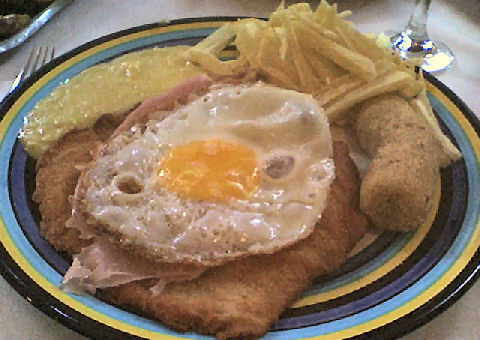
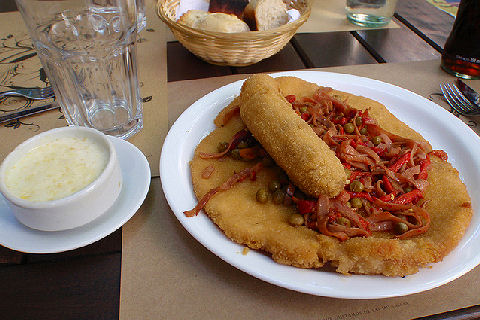
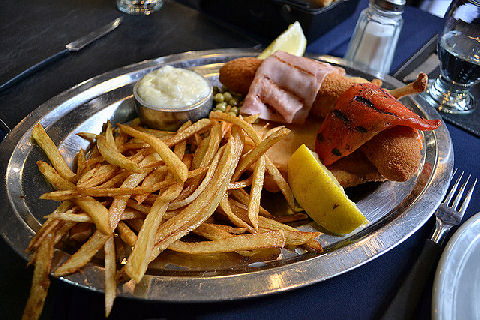
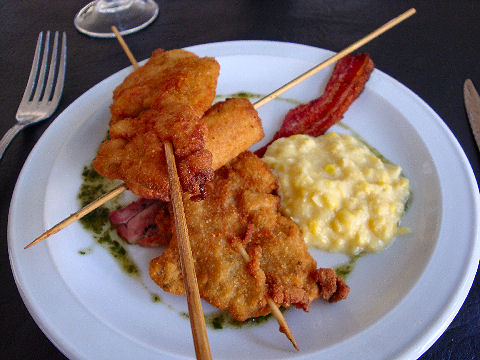
Now, those are the versions I’d tried in the past. Realizing that this dish is one of those that half the classic restaurants in the city probably offer up, I did a search through various sites – Google, TripAdvisor, GuiaOleo, and a few others – for “el mejor”, “the best”, and figured I’d check out a few of those.
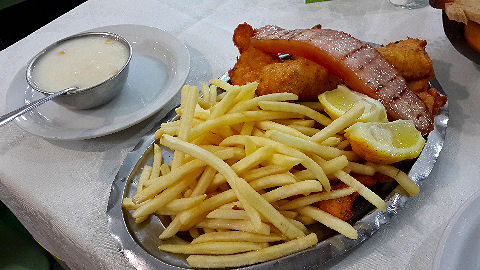
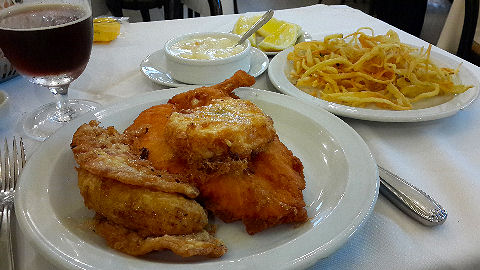
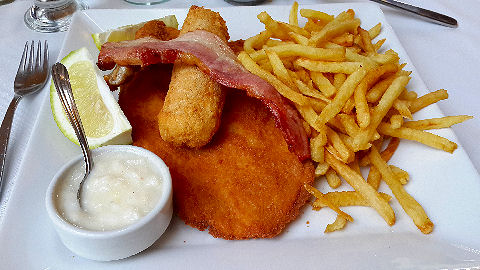
 the creamed corn was more bechamel than corn, but still worked. Although you can’t see it, they serve up a little ramekin of mayo with their bread, but it’s been died with blue and yellow food coloring, swirled through it, to give a lurid sort of aqua shade to it. Doesn’t change the flavor of the mayo, and it was perfectly good on the fries, but it’s just an odd choice for presentation.
the creamed corn was more bechamel than corn, but still worked. Although you can’t see it, they serve up a little ramekin of mayo with their bread, but it’s been died with blue and yellow food coloring, swirled through it, to give a lurid sort of aqua shade to it. Doesn’t change the flavor of the mayo, and it was perfectly good on the fries, but it’s just an odd choice for presentation.
More to come….
[Edit: Apparently I share the fascination with this dish with local chef and Masterchef judge Germán Martitegui of Tegui restaurant, one of the world’s best! He likes the one at Munich restaurant which I’ve not tried.]
The Maryland version with the white gravy sounds suspiciously like chicken-fried chicken. Now, where’s the fried okra?
Jennifer, that version is basically just fried chicken, the biggest differences being that it’s generally finished in the oven or covered and steamed – and, classically, only a flour dredge – no batter or breadcrumbs.
The classical version of this dish (at least it was when I was a kid, 30+ years aho), was always with “papas pay”. Almost the ones that are now common to put on hot dogs (“lluvia de papas”). They were a pain to eat with a fork…
The only place that plated them up with papas pay was Zum Edelweiss – all the others had regular fries. And, like you said, really hard to eat with a fork – I just used my fingers.
[…] stab at a dish influenced by my recent explorations into pollo maryland – it needs more refining. The chicken thigh, simply pan roasted. Served over “popcorn […]
[…] don’t know what possessed me to order a Suprema Maryland as a delivery – fried things are rarely a good move – they tend to steam and get soggy […]
[…] similar series of ventures to find the best Pollo Maryland, a dish that I’m still working on a version […]
[…] on FS ranged from pizza to steak with mushrooms to… oh wait, an apparently spectacular Suprema Maryland. When it arrived I just sort of gawked at it. It was enormous – an entire boneless chicken […]
[…] been things like the ajiaco de conejo (chili rabbit), sesos a la romana (brains, roman style), pollo maryland (chicken maryland), parrillada del mar (seafood mixed grill), and my all time mostest funnest […]
[…] one of the offbeat classics of old school porteño fare, a suprema maryland, which I’d done a whole series on way back. Actually one of the better versions I’ve had, again the ham having been grilled, […]
[…] winning the award for the most reinterpreted dish, Raices’ take on the Suprema Maryland, a dish that I’ve written a fair amount about and have come back to time and again. Both […]
[…] solo at Los Pinos, Azcuenaga 1500, mostly just to try their version of one of my occasional quests, pollo maryland. Good sized portion, nicely cooked, decent flavors, not the best I’ve had, but quite […]
[…] with ham, roasted pepper, creamed corn, shoestring potatoes, and a fried banana. You can read the story about this dish on an earlier post of mine. It’s definitely the best version of this dish I’ve had prepared truly traditionally. I […]
[…] version of the Suprema Maryland, a dish I’ve waxed on about in the past. First off, the suprema itself, superb. A large, whole chicken breast, with the wing drumette […]
sorry but all these versions miss
many of ways it was done in maryland
As for oldest version of dish dates to 1815.
As for the dish getting name goes back to at least
1857. the accepted version in maryland
is pan fried dredged in seasoned flour
cooked in oil or bacon fat. steamed in same pan.
cover cream gravy made from whole milk. flour
and bacon fat. then the bacon is chopped up and
sprinkle top before serving.
No need to apologize…. I appreciate the older dates, I know it was an older recipe, but I couldn’t find a published cookbook reference older than the one I cited. In terms of the recipe you spelled out, though as you noted, there were many ways to make it, isn’t that pretty much exactly what I described in the paragraph introducing the dish? Other than missing that the bacon gets crumbled onto it? The historical description, however, was not intended to be comprehensive, my blog isn’t about food in the US, it’s about food here in Argentina, and the point was to note how that early recipe morphed in different places, particularly here, into the dish we call “Maryland” today in Argentina. The bacon is obviously a common thread, especially with your note about it being crumbled over the top, and the cream gravy is probably what somehow led to the creamed corn accompaniment here (gravies are not big here on meats). As to where the banana came from, that’s probably lost to history.
[…] thin strips of roasted bell pepper for color. We found it a little dry, but with good flavor. The Suprema Maryland is another dish I’ve probably spent even more time exploring, with one longer post on it, and […]
[…] brings the food out to you from the kitchen. I figured I may as well try my old line staple, the chicken maryland. Big portion, two, count them, two fried bananas, plus the egg, ham, canned peas, and mash. Not a […]
[…] readers will remember my on and off obsession with Suprema Maryland, the Argentine version of a classic dish. Fried chicken topped with bacon or ham, roasted peppers, […]